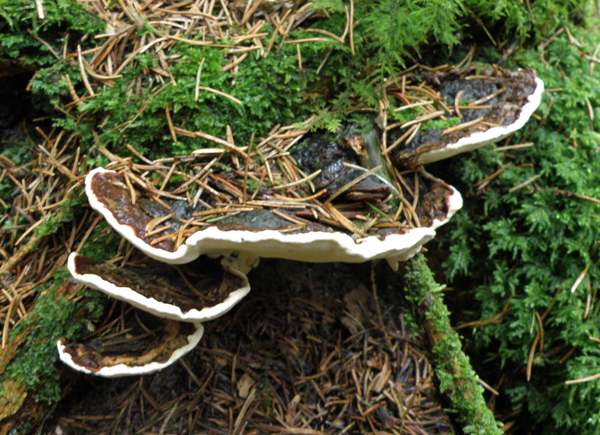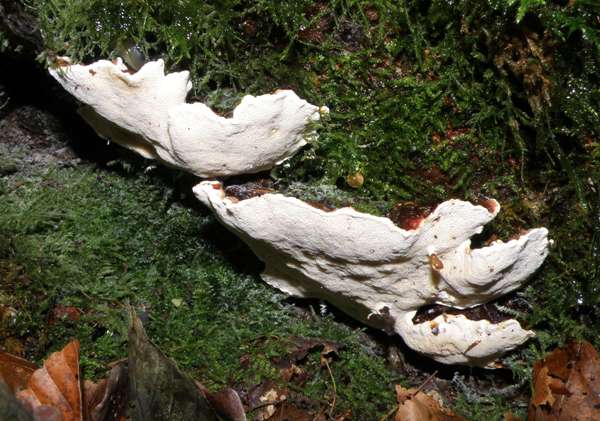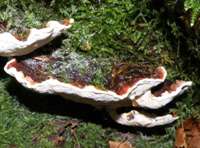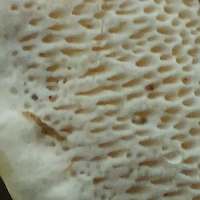Heterobasidion annosum (Fr.) Bref. - Root Rot
Phylum: Basidiomycota - Class: Agaricomycetes - Order: Polyporiales - Family: Bondarzewiaceae
Distribution - Taxonomic History - Etymology - Identification - Culinary Notes - Reference Sources

One of the most serious parasites of conifers, Root Rot is a cause of major economic loss to the conifer forestry industry. Broadleaf trees are not entirely immune to Root Rot: occasionally this root-rotting perennial bracket infects Beech trees and once in a while birches too.
The tough fruitbodies of Fomes Rot, as many forestry managers still call it (an earlier synonym for this species was Fomes annosus), occur low down on the buttress roots.

Trees become infected via wounds to the bark, where the sapwood of buttress roots is exposed. Stumps of freshly felled trees are an open invitation to this fungus, whose mycelium spreads from one tree to another where the roots of adjacent trees rub against one another.
Distribution
A very common and widespread root bracket fungus in Britain and Ireland, Heterobasidion annosum occurs throughout mainland Europe and is also reported to be very common in many parts of North America.
Taxonomic history
When the great Swedish mycologist Elias Magnus Fries described this bracket fungus in 1821 he gave it the binomial scientific name Polyporus annosus. The currently-accepted scientific name of this species dates from an 1888 publication by the German mycologist Julius Oscar Brefeld (1839 - 1925).
Heterobasidion annosum has many synonyms including Boletus cryptarum Bull., Polyporus annosus Fr., Polyporus cryptarum (Bull.) Fr., Poria cryptarum (Bull.) Gray, Fomitopsis annosa (Fr.) P. Karst., Fomes annosus (Fr.) Cooke, Fomes cryptarum (Bull.) Sacc., and Spiniger meineckellus (A. J. Olson) Stalpers.
Etymology
Heterobasidion, the generic name, means 'with variable basidia'. The specific epithet annosum comes from the Latin annus and means aged (many years old - perennial in other words).
Identification Guide
 |
FruitbodyBrown, corrugated upper surface blackening with age; narrow, round-edged brackets; sometimes in tiers and occasionally resupinate; downy when young, then smooth but uneven or knobbly. The individual brackets are 5 to 30cm across and 1 to 2cm thick, often with a wavy margin.
|
 |
Tubes and poresThe tubes are off-white, and they terminate in creamy white round pores that are spaced at between 2 and 4 per mm. A new tube layer 2 to 5mm thick grows each year.
|
SporesBroadly ellipsoidal to subglobose, very finely warty, 4.5-6 x 3.5-4.5µm; inamyloid. Spore printCream or pale yellow. |
|
Odour/taste |
Not distinctive. |
Habitat & Ecological role |
Parasitic on the lower trunks and buttress roots of conifers and very occasionally on some hardwood trees. |
Season |
June to November in Britain and Ireland. |
Similar species |
Gannoderma australe has a thicker fruitbody and releases brown spores. |
Culinary Notes
This bracket fungus is extremely tough and certainly quite inedible.
Reference Sources
Fascinated by Fungi, 2nd Edition, Pat O'Reilly 2016, reprinted by Coch-y-bonddu Books in 2022.
British Mycological Society (2010). English Names for Fungi
Dictionary of the Fungi; Paul M. Kirk, Paul F. Cannon, David W. Minter and J. A. Stalpers; CABI, 2008
Taxonomic history and synonym information on these pages is drawn from many sources but in particular from the British Mycological Society's GB Checklist of Fungi.
Fascinated by Fungi. Back by popular demand, Pat O'Reilly's best-selling 450-page hardback book is available now. The latest second edition was republished with a sparkling new cover design in September 2022 by Coch-y-Bonddu Books. Full details and copies are available from the publisher's online bookshop...

